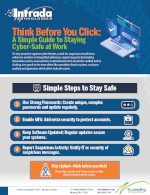Your brand's reputation, built over years, can be at risk in just minutes due to misinformation, negative reviews, or security threats. Learn how proactive strategies and Intrada Technologies' partnership approach can help safeguard your credibility and keep your business thriving.You've spent years...
Think Before You Click: A Simple Guide to Staying Cyber-Safe at Work

OVERVIEW
Cyber threats like phishing are an evolving challenge, using fraudulent messages and websites to trick people into revealing sensitive information. This guide provides key warning signs and simple steps you can take to help protect yourself and our organization from these common online scams.
IN DEPTH

In today’s digital world, cyber threats are a constant and evolving challenge. Each year, thousands of businesses fall victim to cyberattacks, and the consequences can be devastating. According to a recent report by IBM, phishing attacks were responsible for 41% of data breaches in 2022, costing companies an average of $4.91 million per breach. These attacks don’t just target businesses—employees are often the first line of defense, making it essential for everyone to stay vigilant and informed.
Phishing scams remain one of the most common methods used by cybercriminals to gain access to sensitive information. These schemes use fraudulent emails, messages, or websites to trick individuals into revealing passwords, credit card numbers, or other personal data. Unfortunately, one careless click can open the door for hackers to infiltrate your systems. As a general computer user, you play a crucial role in keeping your workplace secure. Developing good cyber habits is not a luxury; it’s a necessity.
What to Watch For
To help you stay proactive against cyber threats, here are some key warning signs and best practices for avoiding phishing and other online scams:
- Suspicious Emails: Look out for emails from unknown senders or addresses that appear slightly misspelled. Scammers often create lookalike domains to mimic legitimate contacts.
- Urgent Requests: Be cautious of messages that claim urgent actions are required, such as resetting passwords or making payments immediately. Pressure is a hallmark of phishing scams.
- Unusual Links or Attachments: Always hover over links to verify their destination before clicking. Avoid opening any attachments unless you’re confident in their legitimacy.
- Too-Good-to-Be-True Offers: Be wary of unexpected offers, prizes, or deals that seem unrealistically generous—they’re likely bait.
- Poor Spelling and Grammar: Legitimate organizations usually send professionally written communications. Errors can be a red flag.
Simple Steps to Stay Safe
- Verify Before Acting: When in doubt, contact the sender through an official communication channel to confirm the request.
- Use Strong Passwords: Employ unique, complex passwords for every account and update them regularly.
- Enable
Multi-Factor Authentication MFA - Keep Software Updated: Regular updates patch vulnerabilities, making your systems more secure.
- Report Suspicious Activity: If you encounter a suspicious email or message, report it immediately to your IT department or security team.
By staying informed and keeping these tips in mind, you can play a critical role in protecting not only yourself but also your organization. Cyberattacks rely on human error, but with vigilance and a safety-first mindset, many of these threats can be avoided. Remember—it only takes one click to compromise your system, so think before you click!
Staying cyber-aware keeps our workplace safe and our information secure. Share this guide with your colleagues and take proactive steps toward a safer digital environment today.
Leveling the Playing Field: Holiday Digital M...
This article provides practical digital marketing strategies for small and medium-sized businesses (SMBs) to compete with larger brands during the holiday season. It emphasizes leveraging local SEO, personalized email marketing, social media engagement, and holiday-themed content to build authentic ...



